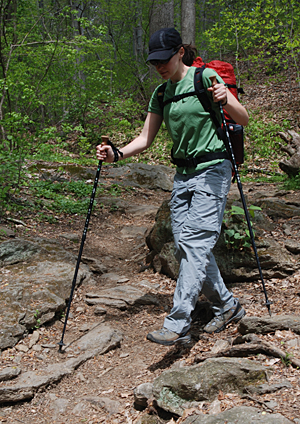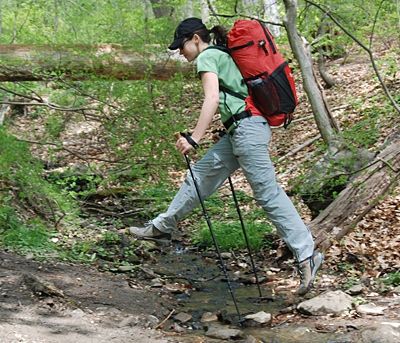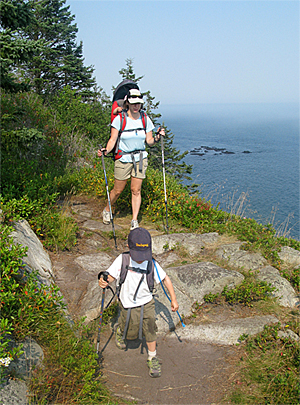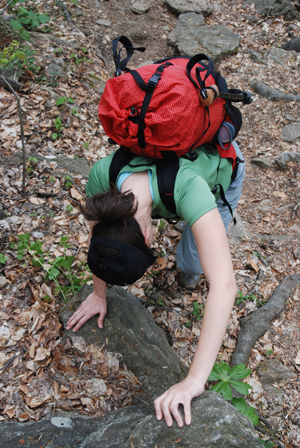 Visit any major trail, and many minor ones, and you'll likely see hikers using trekking poles, matching poles, or walking sticks, specifically designed for hiking. Just a few years ago, many hikers and backpackers didn't know trekking poles existed, and some that did called them “yuppie sticks” or asked pole users, “How's the skiing today?” With increased use, though, attitudes about trekking poles are evolving.
Visit any major trail, and many minor ones, and you'll likely see hikers using trekking poles, matching poles, or walking sticks, specifically designed for hiking. Just a few years ago, many hikers and backpackers didn't know trekking poles existed, and some that did called them “yuppie sticks” or asked pole users, “How's the skiing today?” With increased use, though, attitudes about trekking poles are evolving.
It's not just that it seems like more people are using trekking poles these days: sales figures show that more trekking poles have been sold in the United States in recent years. Sales of trekking poles increased 75 percent from 2007 to 2008, and based on preliminary data, sales of trekking poles are expected to increase another 13 percent from 2009 to 2010, according to Christina DeKraay and Kris Versteegen of SportsOneSource, a sporting goods industry trade publication.
Increased sales aren't just reflective of a fad (remember ankle warmers anyone?). Many regular hikers agree — and loudly proclaim — that trekking poles offer significant benefits. If you haven't yet tried trekking poles, consider the advantages to decide whether they're a worthwhile addition to your gear closet.
Benefits of Trekking Poles
For the hiker or backpacker undecided about if or when to use trekking poles, a good place to start is by examining the benefits poles can offer.
Strength and Fitness

Trekking poles offer improved balance, stability, and fitness. (Photo: Seth Levy)
First, there is evidence that trekking poles enhance the muscle-building and aerobic benefits of hiking. With trekking poles, hikers use upper body muscles they don't ordinarily engage, like biceps, latissimus dorsi (side muscles), pectorals, and triceps. Regularly engaging these muscles while swinging and placing trekking poles will strengthen them. In addition to building upper body muscles, engaging these muscles during a hike creates a full body workout, enhancing the already significant aerobic benefit of hiking.
Trekking poles also can increase the amount of calories burned while hiking. Studies by the Cooper Institute indicate that using nordic walking poles (similar to hiking poles, but designed to be used on paved surfaces) can increase calories burned by an average of 20 percent. These studies were done in a laboratory environment, so it is reasonable to expect that calorie burning might exceed 20 percent on a steep trail. For hikers trekking for fitness, this is welcome news, but long distance hikers should keep in mind that 20 percent more calories burned means 20 percent more calories have to be carried.
Trekking poles are more than just a workout enhancer, though. Many hikers view fitness as an enjoyable side effect of hiking, but not the primary purpose. So how do poles help those who hike for the sake of hiking?
Stability and Balance
According to Lindy Smith, Nordic Walking Instructor and former Marketing Manager of Leki, a major manufacturer of trekking poles, "they improve posture, balance, and stability."
Trekking poles provide two extra points of contact with the trail, essentially converting bipedal hikers into four-legged hiking animals. With more points of contact, hikers are less likely to slip in the first place, and slips are less likely to turn into falls.

Trekking poles help users navigate stream crossings. (Photo: Seth Levy)
Take a minute to think about the situations that lead to a fall on the trail: you step up to climb, and the foot you've weighted slips in a patch of mud or on a wet root. Without trekking poles, it's likely that you'll end up sprawled on the trail. With trekking poles, however, you can brace yourself, retain three points of contact with the trail, and stay on your feet, despite a slip.
Poles also help hikers maintain forward momentum uphill or on tricky terrain, navigate over and around trail obstacles like stream and river crossings, traverse slippery logs and rocks, and improve balance when carrying heavy loads. Many hikers also prefer the steady rhythm of hiking with trekking poles.
Less Stress on Joints
In addition to preventing falls, studies show that trekking poles also prevent pain and damage associated with repetitive stress injuries. Hiking all day, even without a heavy pack, places extraordinary stress on the ankles, knees, and hips. Many hikers can literally feel this force below their knees on steep descents, and above their knees during steep ascents. Poles recruit other muscles to this task and help transfer the weight, reducing the strain that would ordinarily be exclusively absorbed by the joints and muscles in the lower body alone.
A 2007 study in the journal of the American College of Sports Medicine notes that “[a] reduction in the forces, moments, and power around the joint, with the use of poles, will help reduce the loading on the joints of the lower extremity.”
Less stress on one's body can mean enjoying more years of hiking and backpacking.
One Pole or Two?

One pole or two? It comes down to personal preference. (Photo: Dave MacLeay)
A discussion of trekking poles inevitably leads to this frequently asked question: Does it matter if I use one trekking pole or two? Some hikers, especially those out on shorter hikes, prefer to use just one pole, keeping one hand free. But, it stands to reason that engaging both arms to take the load off the knees is more effective than using one arm alone. Additionally, most experts agree that the balance and stability benefits of two poles are greater than one.
Many hikers find that the benefits poles provide become more obvious over time, or with a heavier pack. AT thru-hiker Jeffrey Hunter (trail name: Little Bear) says that he always uses poles for backpacking, but seldom uses them for shorter hikes with less weight. Similarly, Bill Cooke (trail name: Cooker-Hiker) uses poles all the time, considers them “essential on steep descents,” and “wouldn't hike without them.” When to use poles comes down to personal preferences. I often don't use poles on day hikes, but never leave them behind for a multi-day hike.
Potential Drawbacks
Trekking poles provide a considerable range of benefits to hikers — reducing stress on joints and muscles and reducing the likelihood of falling — but also present a few drawbacks to the hiker and potentially the trail itself.
Ecological Impact: Do Poles Trash Trails?
In 2002, Jeffrey L. Marion, Teresa A. Martinez, and Robert D. Proudman, representatives of the Appalachian Trail Conservancy, published a paper in the ATC's newsletter The Register titled "Trekking Poles: Can You Save Your Knees and the Environment?." In the paper, the authors acknowledged the significant benefits that poles offer hikers, while asking hard questions about the potential impacts of trekking poles on trails. The paper noted that trekking poles can cause damage to vegetation, soil, and rocks, and can increase erosion, hastening the tendency of trails to “wash out.”
Might it be true that trekking poles enlarge hiking's impact to a significant level? Possibly, but whether or not this impact is significant remains up to interpretation and some debate. Hikers and trails have a real impact on the environment, but most hikers feel that much of this impact can be outweighed by the increased passion hikers develop to protect natural resources.
For hikers concerned with minimizing the impact of their poles, Marion, Martinez, and Proudman offer the following tips:
- place poles on the trail surface rather than off trail or on vegetation,
- consider the use of rubber pole tips to prevent rock scratching,
- use pole baskets to minimize sinkage (but beware of large baskets snagging vegetation), and
- limit the use of poles, especially in ecologically sensitive areas.
With proper use, the improved balance and agility trekking poles offer can help hikers stay on the trail and durable surfaces and off fragile vegetation, minimizing erosion and impact.
Other Considerations

Stow away poles while scrambling up rocks. (Photo: Seth Levy)
Learning Curve: In addition to potential ecological impacts, trekking poles have some other minor drawbacks. First, they take a little time to adapt to and the typical learning period can involve frustration. I have seen poles dangling from trees, tossed off cliffs, and abandoned mid-hike. This learning phase typically lasts one to four days on a longer hike, or several day hikes in a season. During this period, trekking poles may get caught, feel unwieldy, or cause a paradoxical loss of balance.
Scrambling: Even experienced users recognize that trekking poles aren't appropriate for all situations. On steep trails that call for rock scrambling, trekking poles can get in the way. For example, scrambling through the Appalachian Trail's Mahoosuc Notch in Maine, most hikers collapse their poles and stow them to make the mile-long trek through car-sized boulders. I frequently collapse and stow my poles during the hand-over-hand climbs that are common in New England. Trekking poles may simply be in the way if you're hiking off-trail or through blow down.
Air Travel: Another consideration is the potential difficulty of traveling with poles. This winter, I finished the Appalachian Trail and found myself in Atlanta with a plane ticket home. Carrying on my mud-encrusted trekking poles with sharp carbide tips was not an option, so I mailed them home. But for destination hikers flying to, and back from, a trail, mailing may not be feasible. It is possible to check trekking poles in baggage or a cardboard poster tube, but additional baggage fees can make this a less attractive option.
Wait, what about ski poles?
Over many miles on the trail, one can see a lot of unusual hiking poles. One gentleman I met on the Appalachian Trail carried a stout iron rod that weighed more than 20 pounds.
The price of a shiny set of trekking poles can lead many hikers to contemplate using some cheaper alternatives, like ski poles. Ski poles that fit well are often available at summer yard sales. If you’re not sure whether trekking poles are right for you, hiking with ski poles once or twice is an inexpensive way to experience walking with poles before taking the plunge and buying a real pair.
However, there are numerous reasons not to use ski-poles for hiking long-term. First, the cheap plastic grips often slip off sweaty hands. Second, the tips, meant for snow, wear out quickly on rock. Third, the pole shafts are often thinner, are non-adjustable, and aren’t designed to endure the weight of a hiker with a pack. A pole that suddenly snaps is no joke, and might lead to serious injury. Last, if another hiker asks you how the skiing is, a snappy comeback will be harder to come by.
To Use Poles or Not?
At the end of the trail, individual hikers and backpackers have to weigh the numerous benefits of trekking poles against any drawbacks, both ecological and practical. Increased trekking pole sales suggest that many hikers and backpackers find that the enhanced stability and cardiovascular benefits of poles significantly outweigh the occasional inconveniences. For the vast majority of hikers, trekking poles are helpful and recommended.
In addition to stability and fitness, poles have other benefits worth considering. For example, some trekking poles can be converted into monopods for photographers, and some backpackers use trekking poles as tent pole substitutes to pitch shelters.
If you're still unsure about trekking poles, borrow a pair and give them a try. "I've always heard other hikers talking about how great trekking poles were for their knees, but I didn't become a believer until I tried them out myself," said Ivan Levin, Program Director at the National Park Foundation and frequent hiker. "They make a big difference for my knees and are useful around camp. Now, I hit every trail with trekking poles in hand."
If you've decided that trekking poles are the way to go, now it's time to go out and confront the wide variety of brands, types, and styles of trekking poles available and select a pair of your own:
Selecting a Pair of Trekking Poles
Trekking Pole Fit, Maintenance, and Tips
Citations
"Trekking Poles: Can You Save Your Knees and the Environment? by Jeffrey L. Marion, Teresa A. Martinez, and Robert D. Proudman, Appalachian Trail Conservancy, The Register (2002) (PDF)
http://www.cooperinstitute.org/research/past/nordicwalking.cfm and Church TS, Earnest CP, Morss GM. "Field testing of physiological responses associated with Nordic Walking." Res Q Exerc Sport. 2002 Sep;73(3):296-300

 by Seth Levy
by Seth Levy









